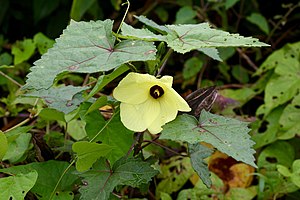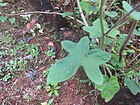Note: This is a project under development. The articles on this wiki are just being initiated and broadly incomplete. You can Help creating new pages.
Difference between revisions of "Abelmoschus moschatus - Latakasturi"
| (7 intermediate revisions by the same user not shown) | |||
| Line 1: | Line 1: | ||
| − | [[File:Abelmoschus moschatus | + | [[File:Abelmoschus moschatus (Malvaceae) (29680066960).jpg|thumb|right|''Latakasturi'', ''Abelmoschus moschatus'']] |
| − | |||
'''Latakasturi''' is an aromatic and medicinal plant. it's family is Malvaceae. Latakasturi is a rich source of dietary fiber. It is native to india, commonly seen growing in [[Western ghats]]. | '''Latakasturi''' is an aromatic and medicinal plant. it's family is Malvaceae. Latakasturi is a rich source of dietary fiber. It is native to india, commonly seen growing in [[Western ghats]]. | ||
==Uses== | ==Uses== | ||
| Line 56: | Line 55: | ||
==Season to grow== | ==Season to grow== | ||
| − | + | April | |
==Required Ecosystem/Climate== | ==Required Ecosystem/Climate== | ||
| − | + | Frost-free climate | |
==Kind of soil needed== | ==Kind of soil needed== | ||
Drained, Rich in nutrients. | Drained, Rich in nutrients. | ||
| − | |||
| − | |||
==Commonly seen growing in areas== | ==Commonly seen growing in areas== | ||
| Line 76: | Line 73: | ||
Abelmoschus Moschatus - കസ്തൂരി വെണ്ട 02.jpg|Whole plant | Abelmoschus Moschatus - കസ്തൂരി വെണ്ട 02.jpg|Whole plant | ||
Abelmoschus Moschatus - കസ്തൂരി വെണ്ട 03.jpg|Seeds | Abelmoschus Moschatus - കസ്തൂരി വെണ്ട 03.jpg|Seeds | ||
| − | Abelmoschus Moschatus - കസ്തൂരി വെണ്ട 05.jpg|Leaf | + | Abelmoschus Moschatus - കസ്തൂരി വെണ്ട 05.jpg|Leaf |
</gallery> | </gallery> | ||
| + | <ref name="Photo Gallery"/> | ||
==References== | ==References== | ||
| Line 87: | Line 85: | ||
<ref name="How to plant/cultivate">[https://www.pfaf.org/user/Plant.aspx?LatinName=Abelmoschus+moschatus Cultivation details]</ref> | <ref name="How to plant/cultivate">[https://www.pfaf.org/user/Plant.aspx?LatinName=Abelmoschus+moschatus Cultivation details]</ref> | ||
| + | |||
| + | <ref name="Photo Gallery">[https://creativecommons.org/licenses/by-sa/2.0/deed.en These files are licensed under the Creative Commons]</ref> | ||
</references> | </references> | ||
Latest revision as of 12:57, 26 April 2023
Latakasturi is an aromatic and medicinal plant. it's family is Malvaceae. Latakasturi is a rich source of dietary fiber. It is native to india, commonly seen growing in Western ghats.
Contents
- 1 Uses
- 2 Parts Used
- 3 Chemical Composition
- 4 Common names
- 5 Properties
- 6 Habit
- 7 Identification
- 8 List of Ayurvedic medicine in which the herb is used
- 9 Where to get the saplings
- 10 Mode of Propagation
- 11 How to plant/cultivate
- 12 Season to grow
- 13 Required Ecosystem/Climate
- 14 Kind of soil needed
- 15 Commonly seen growing in areas
- 16 Photo Gallery
- 17 References
- 18 External Links
Uses
Fever, Controls hysteria, Stimulates sexual desire, Inflammation, Gastric, Blotches, Pimples, Diarrhea, Sore throats
Parts Used
Chemical Composition
Roots, leaves, fruits and seeds contain mucilage. Leaves, flower petals and fruit husk contain ß-sitosterol and its glycosides. Flowers contain flavonoids, myricetin, its glucoside and cannabistrin and petals contain myricetin and its glucoside.[1]
Common names
| Language | Common name |
|---|---|
| Kannada | Kaadukasthuri, Kasthuribende |
| Hindi | Muskdana |
| Malayalam | Kaattukasturi, Kasturivenda |
| Tamil | Kattuk-Kasturi, Kasturivendai |
| Telugu | Karpura-Benda |
| Marathi | NA |
| Gujarathi | NA |
| Punjabi | NA |
| Kashmiri | NA |
| Sanskrit | Latakasturika, Latakasturi |
| English | Ambrette, Musk Mallow |
Properties
Reference: Dravya - Substance, Rasa - Taste, Guna - Qualities, Veerya - Potency, Vipaka - Post-digesion effect, Karma - Pharmacological activity, Prabhava - Therepeutics.
Dravya
Rasa
Tikta (Bitter), Madhura (Sweet), Katu (Pungent)
Guna
Laghu (Light), Ruksha (Dry)
Veerya
Sheeta (Cold)
Vipaka
Katu (Pungent)
Karma
Kapha, Pitta
Prabhava
Habit
Identification
Leaf
| Kind | Shape | Feature |
|---|---|---|
| Simple | Alternate | Leaves alternate, rough, hairy,heart-shaped or 3-7 palmately lobed with serrate margins and linear-oblong or triangular lobes, 4-10cm x 4-9 cm |
Flower
| Type | Size | Color and composition | Stamen | More information |
|---|---|---|---|---|
| bisexual | 2-4cm long | Yellow | 8-12 | Flowering is October and April in some places, depending on the timing of the wet season |
Fruit
| Type | Size | Mass | Appearance | Seeds | More information |
|---|---|---|---|---|---|
| Hirsute | 6-8 cm long | Fruit a hirsute capsule, 6-8 cm long, ovoid-cylindrical | With hooked hairs | {{{6}}} |
Other features
List of Ayurvedic medicine in which the herb is used
Where to get the saplings
Mode of Propagation
How to plant/cultivate
Easily grown in a rich well-drained soil in a sunny position.[3]
Season to grow
April
Required Ecosystem/Climate
Frost-free climate
Kind of soil needed
Drained, Rich in nutrients.
Commonly seen growing in areas
Tropical area, Moist deciduous forests.
Photo Gallery
References
External Links
- Ayurvedic Herbs known to be helpful to treat Fever
- Ayurvedic Herbs known to be helpful to treat Controls hysteria
- Ayurvedic Herbs known to be helpful to treat Stimulates sexual desire
- Ayurvedic Herbs known to be helpful to treat Inflammation
- Ayurvedic Herbs known to be helpful to treat Gastric
- Ayurvedic Herbs known to be helpful to treat Blotches
- Ayurvedic Herbs known to be helpful to treat Pimples
- Ayurvedic Herbs known to be helpful to treat Diarrhea
- Ayurvedic Herbs known to be helpful to treat Sore throats
- Herbs with Leaves used in medicine
- Herbs with Roots used in medicine
- Herbs with Seeds used in medicine
- Herbs with common name in Kannada
- Herbs with common name in Hindi
- Herbs with common name in Malayalam
- Herbs with common name in Tamil
- Herbs with common name in Telugu
- Herbs with common name in Sanskrit
- Herbs with common name in English
- Habit - Perennial plant
- Index of Plants which can be propagated by Seeds
- Index of Plants which can be propagated by Cuttings
- Herbs that are commonly seen in the region of Tropical area
- Herbs that are commonly seen in the region of Moist deciduous forests
- Herbs
- Plants of western ghats
- Shrub
- Malvaceae






